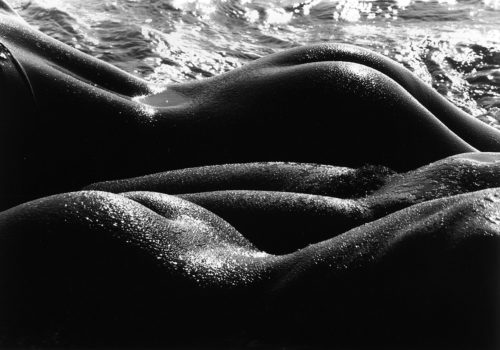Lucien Clergue, was born in Arles in 1934 a few steps from the arenas. He was brought up by his mother, a grocer in La Roquette, the neighborhood of the Rhône sailors and gypsies.
A man from the South, he photographed his territory and its inhabitants, the sands, the nudes in the sea, the gypsies, his native Camargue, and immerses us in Mediterranean civilization.
For nearly sixty years, light and shadow haunted the artist’s work. It is in black and white that he has chosen to make us aware of his universe which summarizes the cycle of life: Eros and Thanatos.
Deeply marked by the war and the early death of his mother, he went through a dark period by photographing difficult subjects such as carrion from an early age.
After his sad and melancholy early period, the light appears in his work with the nudes of the sea. Life returned on the beaches of Camargue and in the waves, the woman became Aphrodite emerging from the waters, an eternal inspiration.
By removing the model’s face, he gave it a timeless dimension and transformed the woman into a real living antique sculpture. It is rediscovered vitality, the return of Eros.
Lucien Clergue told us about the origin of the world. He approached unspoiled nature, the grain of sand, observed the blowing of the wind on a single blade of grass, insects. Man entered the scene, leaving his mark on the sand, that of his car, his dog, abandoned his waste, plastic. The photographer was fascinated by the eternal renewal. He was the first photographer to defend a 3rd cycle thesis without any text, only with images, “Language des Sables”. Roland Barthes wrote an introductory text to the book published in 1980.
He captured the soul of the gypsy community persecuted during the war, which awakened his emotions as a poet photographer and cast a look of great benevolence on their daily lives. He became friends with José Reyes, the father of the Gipsykings and discovered the guitarist Manitas de Plata with whom he toured the world.
His meeting with Jean Cocteau in 1956 was decisive. He participated in the publication of the first book by Lucien Clergue, Memorable Corps in the company of Picasso. The photographer fed the poet by sending him his photos of gypsies those helped him create his frescoes in the Saint-Pierre chapel in Villefranche. In 1959, he made the film Le Testament d’Orphée in Les Baux de Provence. Again, he found invaluable help from the photographer for the gypsy part of the film and invited him to photograph the shoot.
Inspired artist, he directed many short films Delta de Sel, Voyage en Camardie, Sables, Le Phare, Dans Arles where the Alyscamps are.
Organized by the City of Toulon, in collaboration with the Atelier Lucien Clergue, the exhibition brings together a hundred photographs revealing the most intimate part of the photographer’s universe: women, nature, Jean Cocteau and gypsies, travelers of the wind.
Lucien Clergue is the first photographer elected to the Academy of Fine Arts of the Institut de France in 2006, he inaugurated the VIIIth Section devoted to Photography. He has exhibited worldwide and published over 80 books. His photographs are in the collections of many institutions.
Since his death in 2014, the Grand Palais devoted a major exhibition to him in 2015 on “The first albums”.
I am very happy to offer the City of Toulon a new proposal which gives a new reading to the Mediterranean photographer.
Curator, Anne Clergue
Find Lucien Clergue’s publications and news on the lucien-clergue.fr website
“Lucien Clergue, The Mediterranean” – June 10-September 18, 2022
MAISON DE LA PHOTOGRAPHIE
RUE NICOLAS LAUGIER, PLACE DU GLOBE — TOULON
GALERIE DES MUSÉES
22, RUE PIERRE SÉMARD — TOULON
CABINET D’ART GRAPHIQUE, MUSÉE D’ART DE TOULON
113 BD LECLERC — TOULON
10 JUNE – 18 SEPTEMBER 2022
ACCESSIBLE WITH THE RENCONTRES D’ARLES 2022 PASS.
https://www.rencontres-arles.com/en/expositions/view/1109/lucien-clergue
















